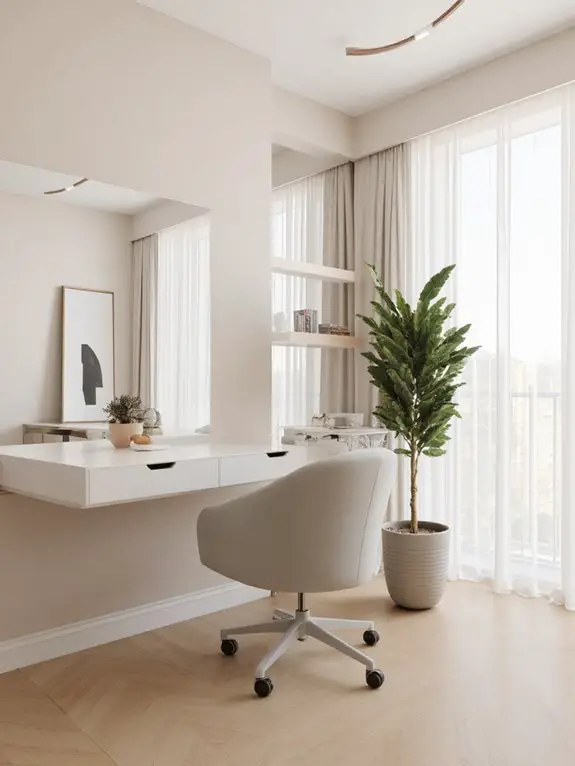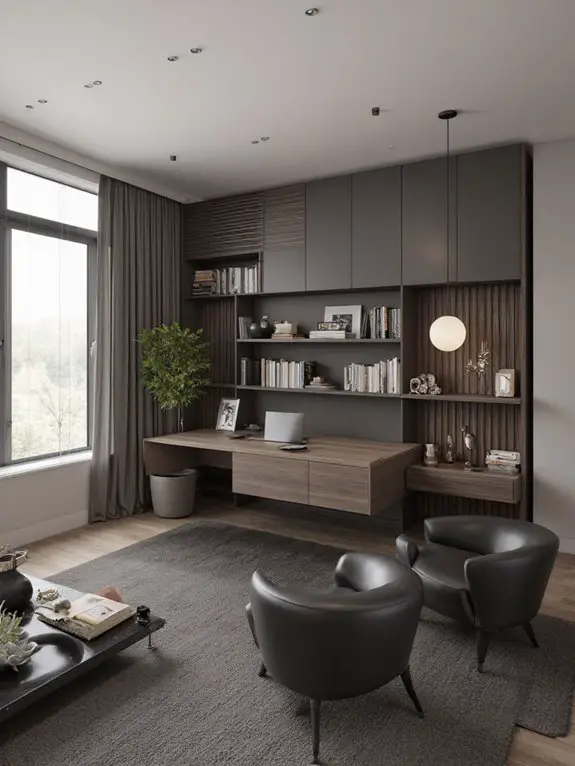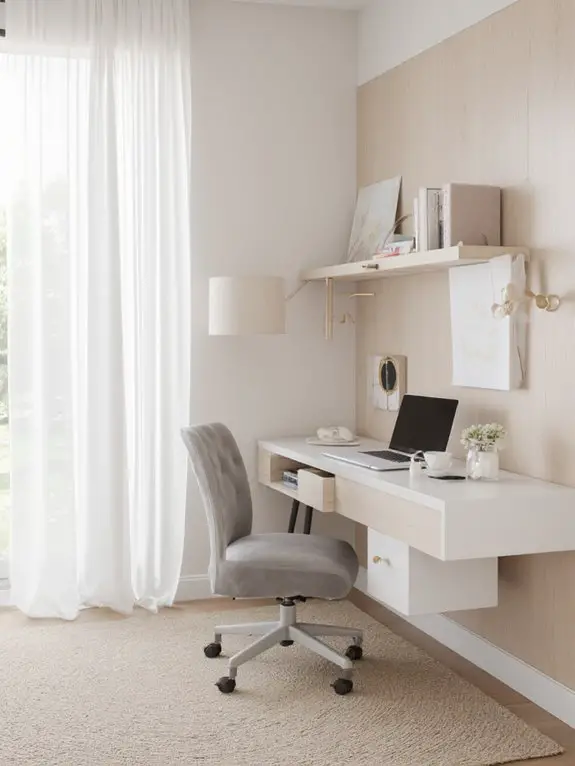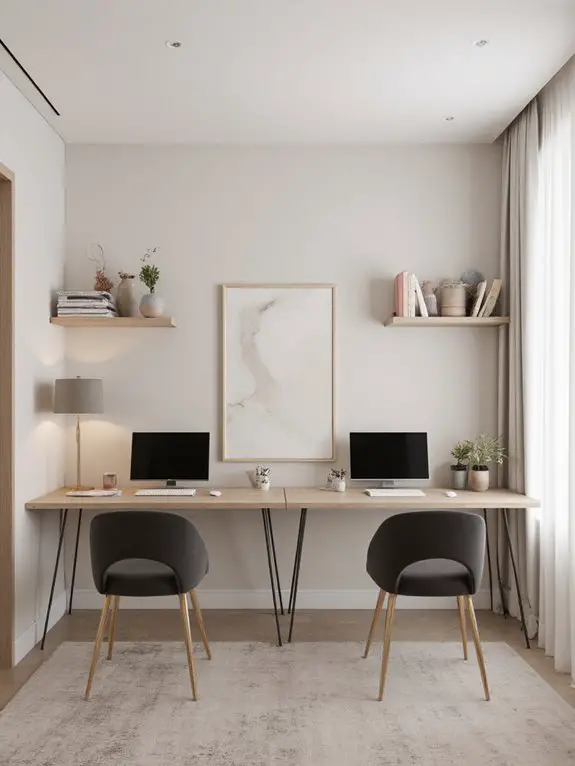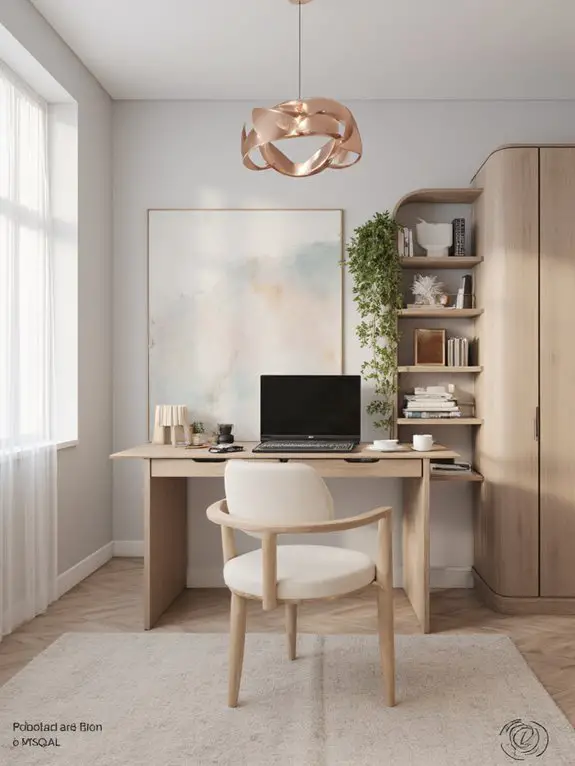I focus on a minimalist home office by choosing a desk with clean lines and compact storage. Neutral colors like white, beige, or gray create a serene backdrop, while floating shelves keep essentials organized without clutter. A sleek, functional chair adds personality without overwhelming the space. I keep cables tidy with clips or sleeves and opt for wireless devices to reduce mess. Minimal decor and open floor space enhance focus and productivity—there’s more to uncover.
Choose a Minimalist Desk Design
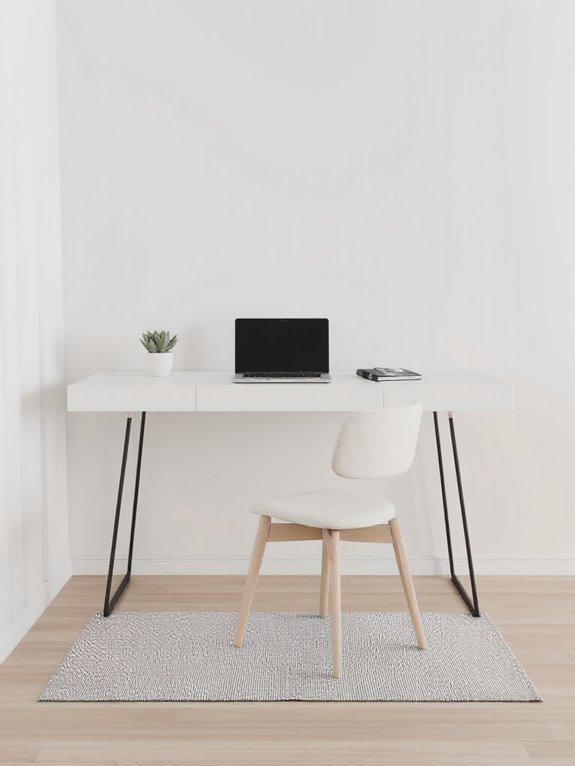
When selecting a minimalist desk design, I always prioritize functionality and simplicity. I look for clean lines, minimal ornamentation, and a compact footprint that maximizes my workspace without overwhelming the room.
I prefer materials like wood or metal for durability and timelessness, and I make certain the desk has just enough storage—like a drawer or shelf—to keep essentials organized yet out of sight. Cable management is key, so I opt for designs that hide cords or integrate ports neatly.
Ultimately, I choose a desk that complements my workflow, guaranteeing it’s practical, visually unobtrusive, and supports my focus on productivity.
Opt for Neutral Color Palettes
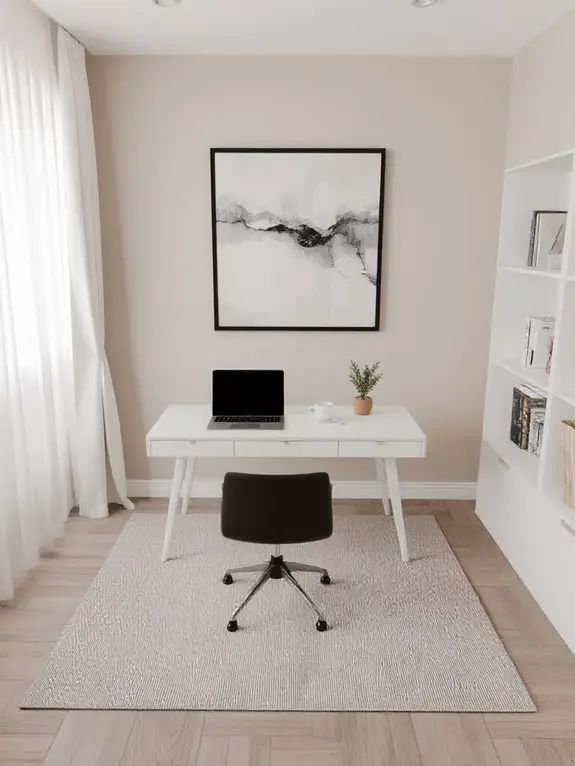
Neutral color palettes create a calming and focused atmosphere in a minimalist home office, helping me stay centered and productive. I stick to shades like white, beige, gray, or soft taupe because they reduce visual distractions and make the space feel open and airy.
These colors also act as a timeless backdrop, allowing furniture and decor to stand out without overwhelming the room. I’ve found that pairing neutral walls with accents in natural materials, like wood or linen, enhances serenity.
Avoiding bold or contrasting colors keeps my mind clear and guarantees the office remains a peaceful haven for work.
Use Floating Shelves for Storage
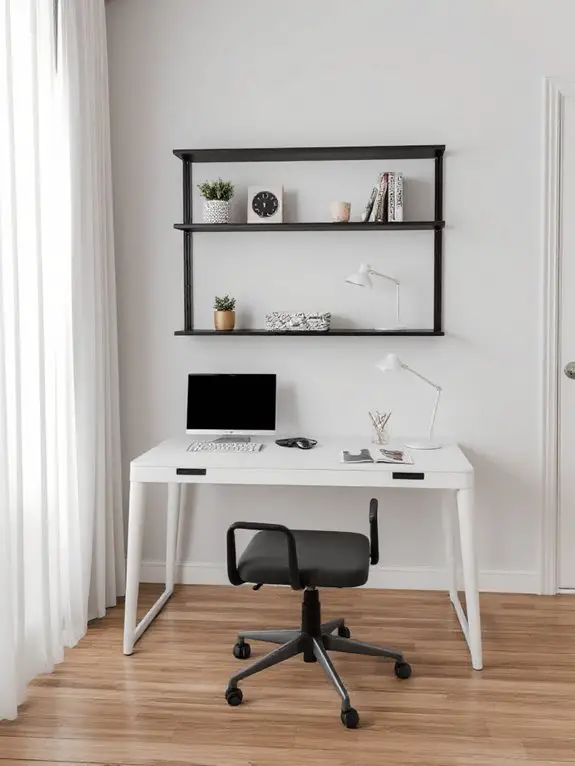
Floating shelves are a practical and stylish solution for storage in a minimalist home office. They keep essentials within reach without cluttering your workspace, maintaining the clean, open feel that’s central to minimalism.
I prefer using shelves made from natural materials like wood or metal for a sleek, timeless look. Positioning them above your desk or along a bare wall maximizes vertical space, freeing up your desk for work.
I organize items like books, folders, and small decor in a deliberate, visually pleasing way. Keeping the shelves uncluttered guarantees they enhance the room’s aesthetic while serving a functional purpose.
Incorporate a Statement Chair
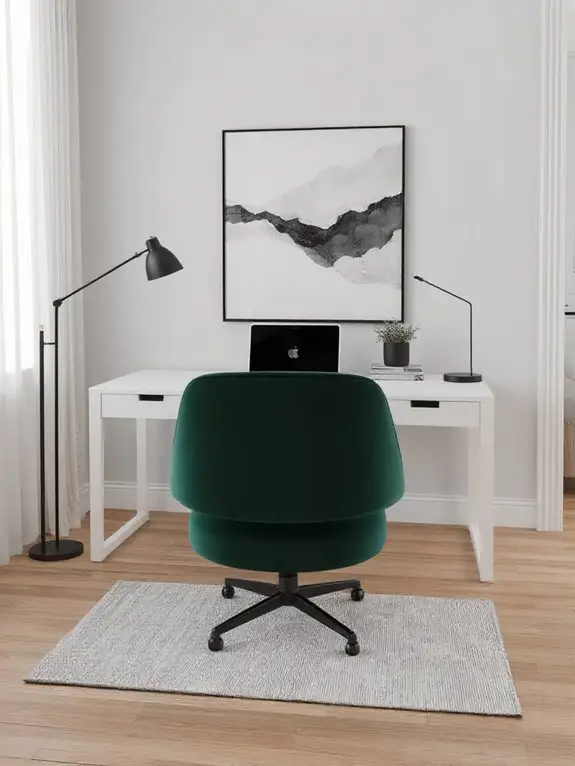
While a minimalist home office emphasizes simplicity, a statement chair can anchor the space without compromising its clean aesthetic. I’ve found that choosing a chair with a bold design or unique color adds personality without overwhelming the room.
Opt for a sleek, ergonomic piece that blends form and function—think mid-century modern or Scandinavian styles. I prefer neutral tones but sometimes introduce a pop of color to create a focal point.
Position it in a way that balances the desk and complements the overall layout. A statement chair not only elevates the look but also makes the workspace feel intentional and inviting.
Keep Cables Organized and Hidden
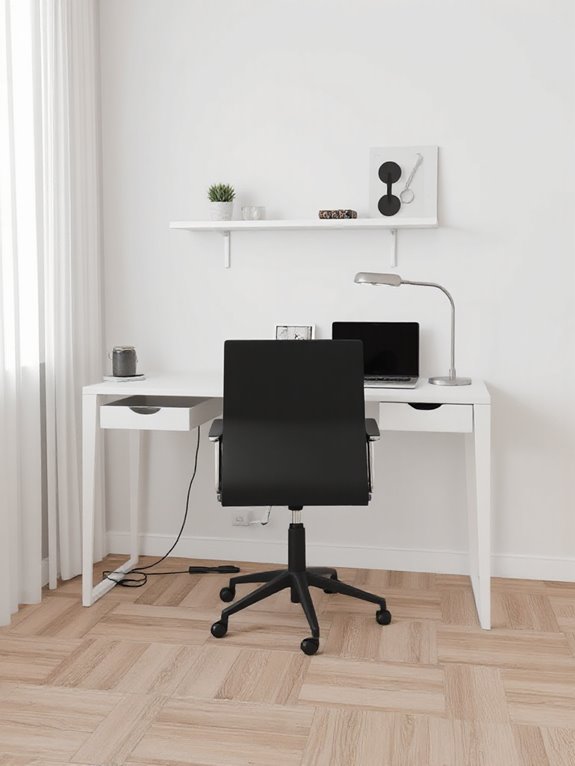
To maintain a minimalist home office, it’s essential to keep cables organized and hidden, as clutter from wires can quickly disrupt the clean, streamlined look you’re aiming for.
I start by using cable clips or sleeves to bundle cords together, keeping them neat and out of sight. A cable management box is another great solution—it tucks power strips and excess wiring into one discreet container.
For devices on my desk, I route cables behind or underneath furniture, securing them with adhesive hooks. Wireless peripherals also help reduce cable chaos, making my workspace feel instantly more polished and intentional.
Add a Single Potted Plant
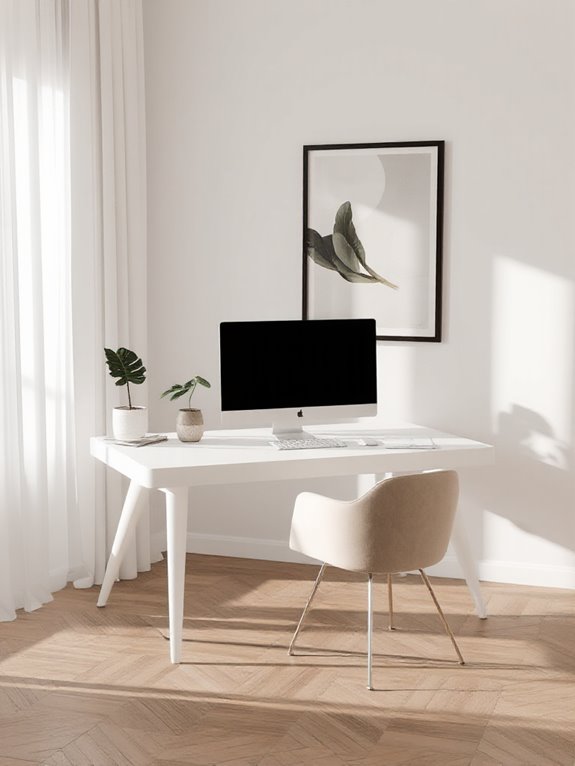
Even in a minimalist home office, a single potted plant can introduce life and warmth without overwhelming the space. I prefer choosing a low-maintenance option like a snake plant or pothos, as they thrive in indirect light and require minimal care.
Place it on your desk, a shelf, or in a corner to add a subtle touch of nature. The plant’s greenery can soften the aesthetic and improve air quality, making the space feel more inviting.
Just make sure the pot aligns with your minimalist theme—neutral colors or simple ceramic designs work best. It’s a small addition that makes a big impact.
Install Minimalist Lighting Fixtures
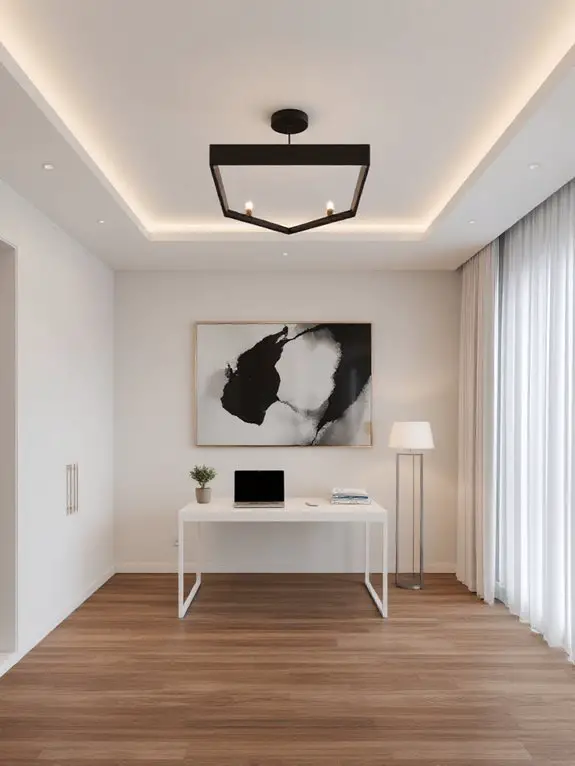
When designing a minimalist home office, lighting plays a pivotal role in creating a functional and aesthetically pleasing environment. I focus on sleek, simple fixtures that blend seamlessly with the space. A pendant light with clean lines or a geometric desk lamp works wonders.
I prioritize natural light first, positioning my desk near a window to reduce clutter from additional lamps. For evenings, I use LED bulbs with warm tones to maintain a calming ambiance.
Dimmer switches are a small addition that make a big difference, allowing me to adjust brightness as needed. Minimalist lighting is about quality, not quantity.
Use a Wall-Mounted Monitor
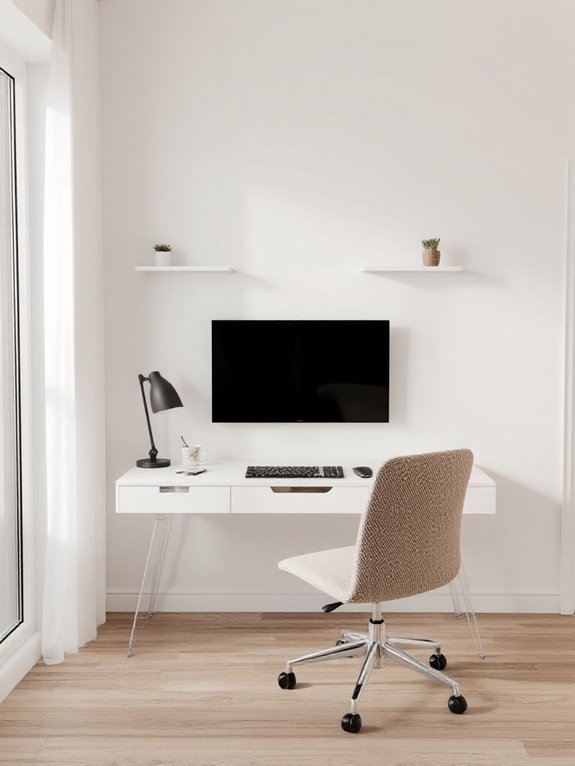
A wall-mounted monitor can substantially enhance the minimalist aesthetic of a home office while maximizing desk space. I’ve found that mounting my monitor on the wall not only frees up valuable surface area but also creates a clean, uncluttered look.
It’s important to choose a monitor arm or bracket that complements your workspace and allows for adjustable height and tilt. I recommend positioning the monitor at eye level to reduce strain and improve ergonomics.
Cable management is key—I use adhesive clips or a raceway to keep wires neatly organized. This simple change transforms functionality and elevates the overall design effortlessly.
Declutter Your Desktop Regularly

To maintain a minimalist home office, decluttering your desktop regularly is essential—it keeps the space functional and visually calming. I make it a habit to sort through papers, files, and gadgets weekly, removing anything unnecessary.
I use trays or organizers to categorize items by purpose, ensuring everything has a designated spot. Digital clutter is equally important; I delete unused files, organize folders, and clear my screensaver for a cleaner look.
Invest in Multi-Functional Furniture
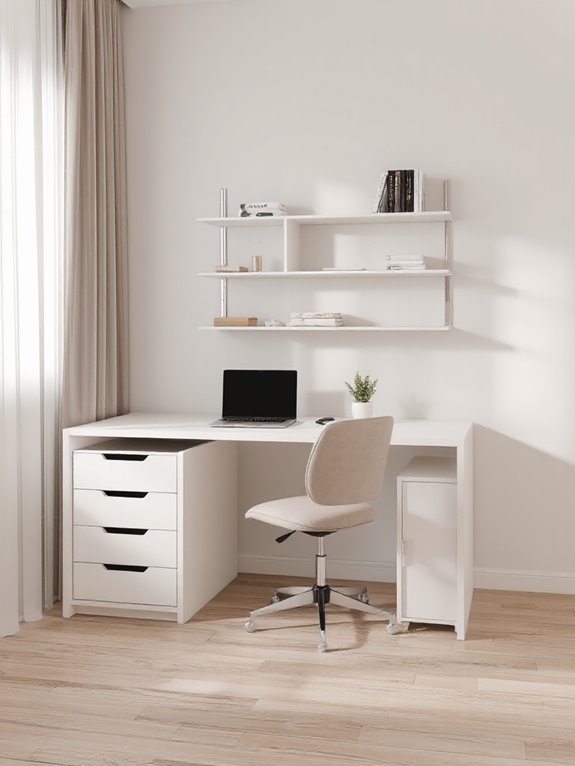
Since space is often limited in a home office, I’ve found that investing in multi-functional furniture can maximize both functionality and aesthetics. A desk with built-in shelves or drawers, for example, eliminates the need for separate storage units, keeping the area tidy. I also love using a foldable desk or wall-mounted table that can be tucked away when not in use, freeing up floor space.
An ottoman with hidden storage doubles as seating and a place to stash supplies. Choosing furniture that serves multiple purposes not only saves space but also creates a sleek, uncluttered environment that boosts productivity.
Utilize Drawer Dividers for Organization
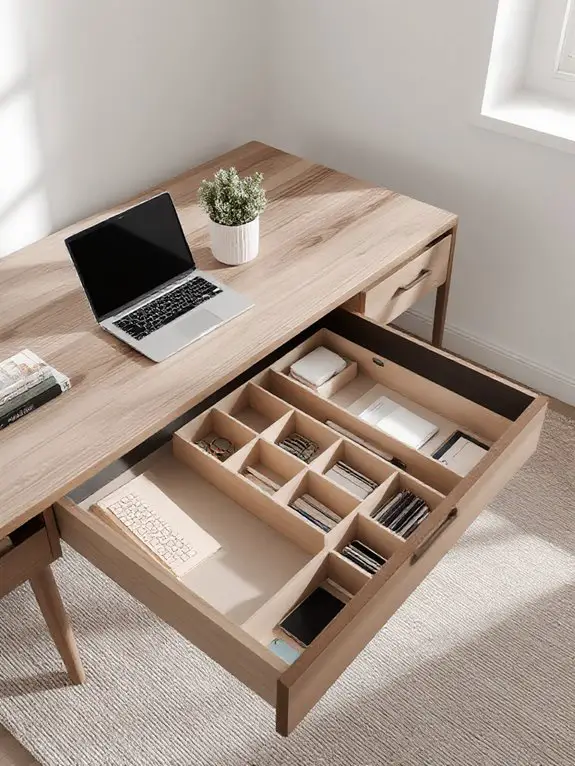
After optimizing space with multi-functional furniture, keeping drawers organized becomes the next step to maintaining an efficient home office. I’ve found that drawer dividers are essential for separating items like pens, sticky notes, and cords, ensuring everything has a designated spot.
Using adjustable dividers allows me to customize compartments as my needs change. I also suggest grouping similar items together and labeling sections for quick access. This system not only reduces clutter but also saves time by eliminating the frustration of rummaging through messy drawers.
Hang Inspirational Artwork Sparingly
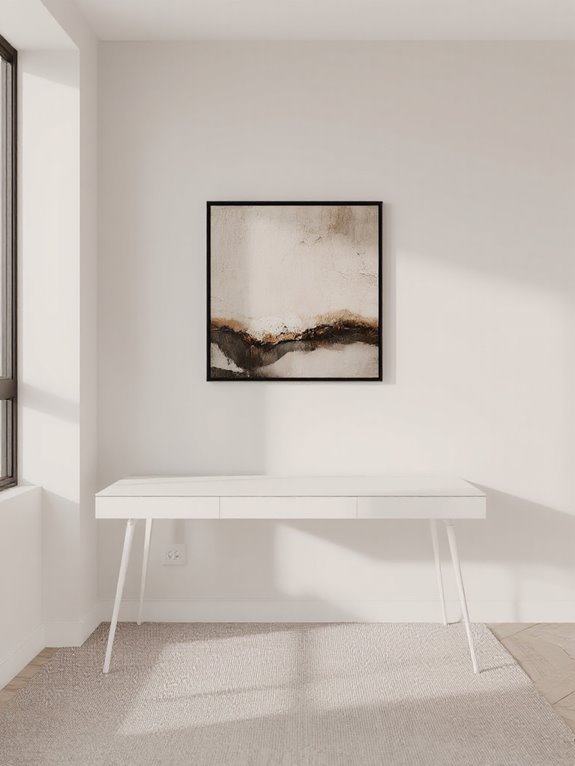
While a minimalist home office thrives on simplicity, adding a few carefully chosen pieces of inspirational artwork can enhance focus and motivation. I recommend selecting one or two meaningful pieces—like a motivational quote or a serene landscape—to avoid visual clutter.
Position them where they’ll catch your eye during breaks or moments of fatigue. Opt for frames that match your office’s neutral palette to maintain cohesion.
Art should uplift without overwhelming; think quality over quantity. A single striking piece above your desk can serve as a subtle reminder of your goals, reinforcing productivity without disrupting the clean aesthetic.
Choose a Simple Rug or Carpet
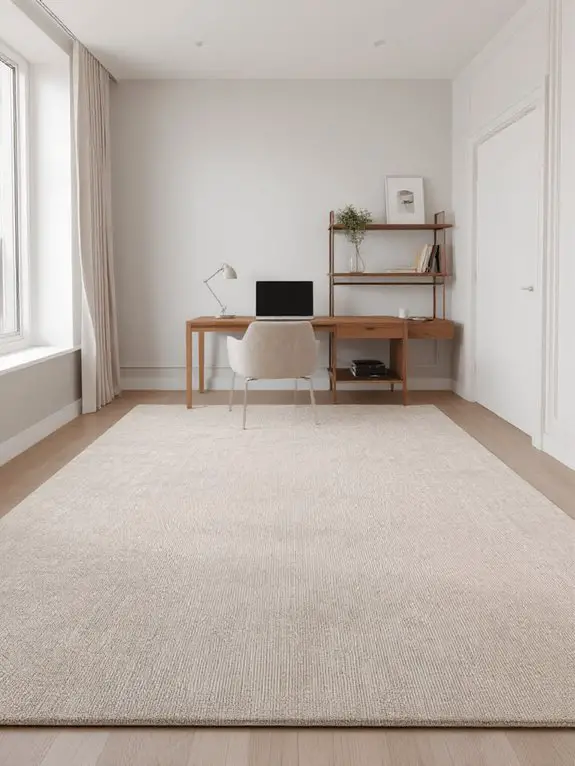
A simple rug or carpet can anchor your minimalist home office, adding warmth and texture without overwhelming the space. I opt for neutral tones like beige, gray, or white to maintain a clean, cohesive look.
A low-pile rug works best for practicality, ensuring it’s easy to clean and doesn’t trap dirt. Natural materials like wool or jute can introduce subtle texture while staying true to the minimalist aesthetic.
I make sure the rug’s size complements the desk and chair area, creating a defined workspace. It’s a small detail that enhances comfort and ties the room together without unnecessary distractions.
Limit Decorative Items to Essentials
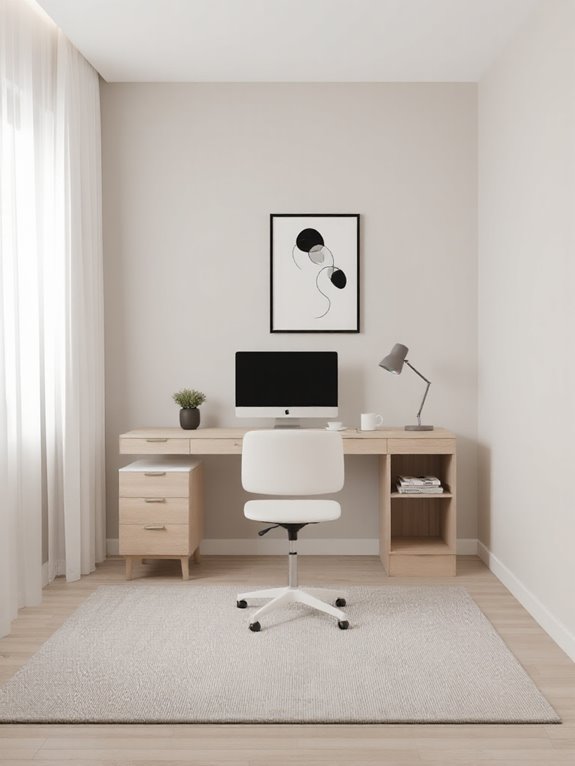
To maintain a minimalist home office, I focus on limiting decorative items to only what’s essential, ensuring the space feels uncluttered yet intentional. I choose pieces that serve a dual purpose, like a stylish lamp that also provides task lighting or a small potted plant that adds life without overwhelming the area.
Artwork is kept minimal—one impactful piece that inspires me rather than several competing for attention. Storage solutions are discreet, blending into the design.
Use a Digital Calendar Instead of a Physical One
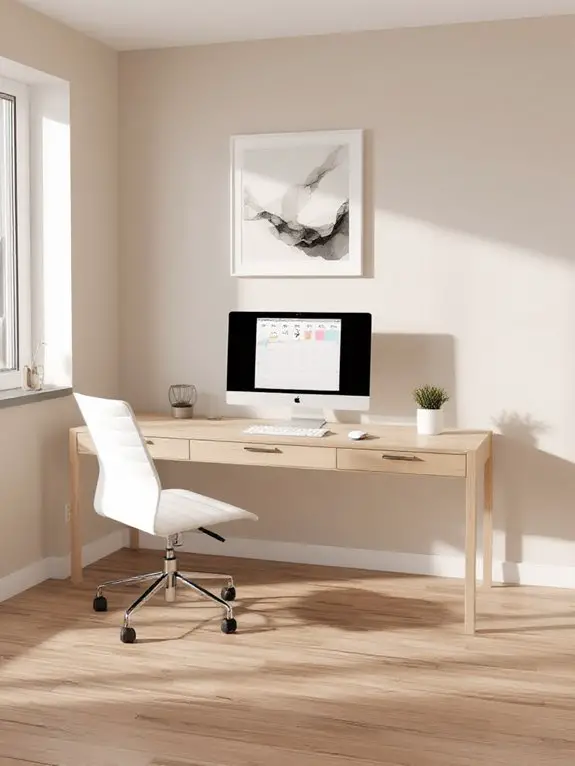
Switching to a digital calendar has streamlined my organization in ways a physical calendar simply couldn’t match. I can access it from any device, sync it across platforms, and set reminders that keep me on track.
It’s also easier to make quick edits without the mess of erasing or rewriting. I’ve found that color-coding tasks and events helps me prioritize efficiently, and integrating it with email or project management tools saves time.
Plus, it reduces clutter in my workspace, aligning perfectly with a minimalist approach. It’s a simple switch, but it’s made managing my schedule far more effective.
Opt for Slim and Sleek Office Accessories

Choosing slim and sleek office accessories has transformed my workspace by eliminating visual clutter while maintaining functionality. I switched to a compact wireless keyboard, a flat monitor stand, and a minimalist desk lamp with a slim profile. These items not only save space but also create a cleaner, more focused environment.
I also replaced bulky file organizers with a thin document tray and opted for a sleek, cable-free mouse. The streamlined design of these accessories enhances the aesthetic of my desk and makes it easier to concentrate.
Prioritizing minimalism in my office tools has substantially boosted both productivity and peace of mind.
Incorporate Hidden Storage Solutions
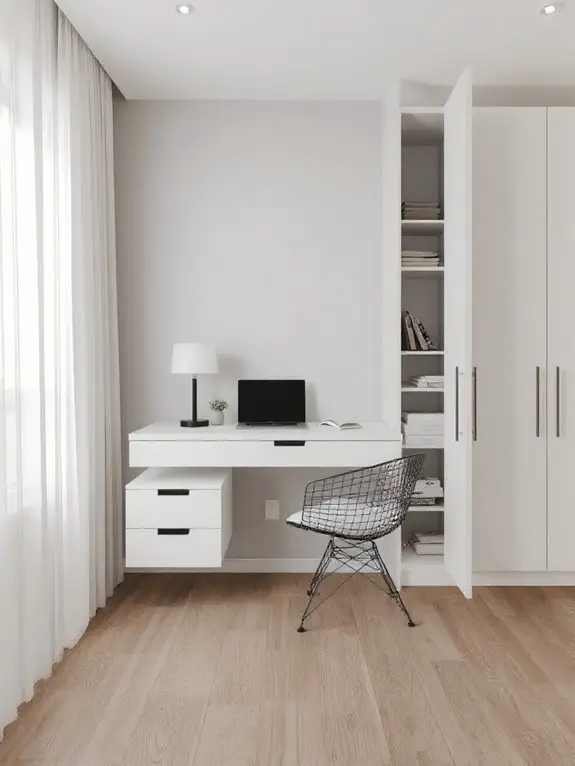
Streamlining my office accessories has made a noticeable difference, but I quickly realized that true minimalism also requires smart storage solutions that keep clutter out of sight.
I’ve incorporated furniture with built-in compartments, like desks with hidden drawers and shelves with concealed cabinets. Wall-mounted units and floating shelves maximize vertical space while maintaining a clean look.
I also use decorative boxes or baskets to store loose items, ensuring they blend seamlessly with the room’s aesthetic. By tiding away cables, documents, and supplies in these hidden spaces, I maintain functionality without sacrificing the serene, uncluttered vibe of my minimalist home office.
Install a Whiteboard or Pinboard for Essentials

To keep my home office organized and efficient, I’ve found that installing a whiteboard or pinboard is essential for managing tasks and reminders without cluttering my workspace. I use my whiteboard to jot down daily priorities, deadlines, and brainstorming ideas, which keeps everything visible and accessible.
A pinboard helps me display important notes, schedules, or inspiration without adding unnecessary items to my desk. Both tools are sleek, functional, and blend seamlessly into my minimalist setup.
Keep Office Supplies in a Single Drawer
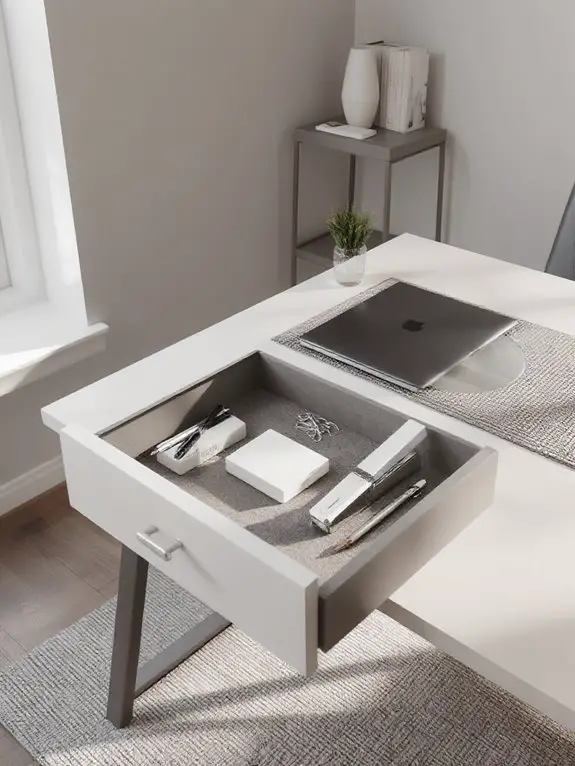
While a whiteboard or pinboard helps manage tasks and ideas, keeping office supplies organized is equally important for maintaining a clutter-free workspace. I’ve found that limiting all my supplies to a single drawer not only saves space but also reduces visual distractions.
I use small containers or dividers to sort items like pens, sticky notes, and paper clips, ensuring everything has its place. Before adding a new item, I evaluate whether it’s truly necessary, preventing clutter from creeping in.
This approach keeps my desk clear and my focus sharp, making it easier to stay productive in my minimalist home office.
Use a Laptop Stand for Ergonomics
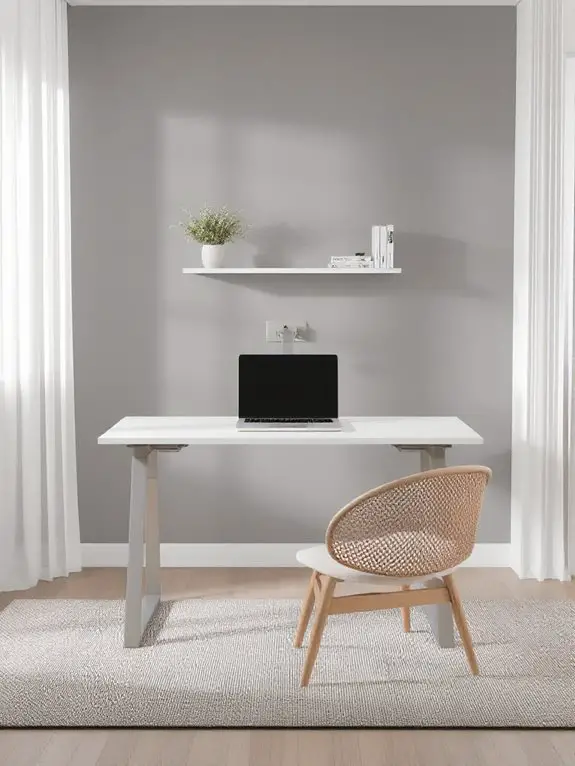
Using a laptop stand can markedly enhance your posture and reduce strain during long work hours. I’ve found that elevating my laptop brings the screen to eye level, preventing me from hunching over. This simple adjustment alleviates neck and back discomfort while improving my focus.
Many stands are adjustable, letting me customize the height for ideal comfort. I also appreciate how it frees up desk space, keeping my workspace tidy and minimalist.
Pairing it with an external keyboard and mouse creates a more ergonomic setup without cluttering the desk. Investing in a quality stand is a small change that yields significant health benefits.
Choose a Minimalist Mouse and Keyboard
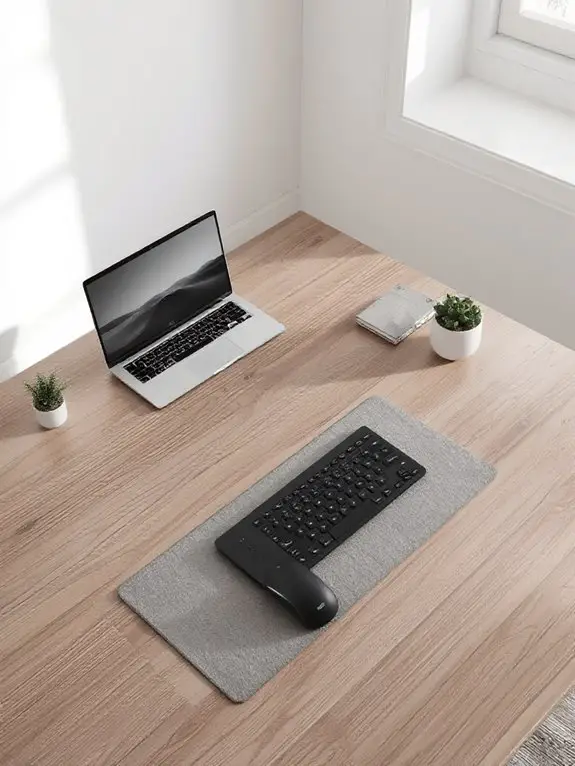
Pairing a minimalist mouse and keyboard with a laptop stand keeps my workspace both ergonomic and clutter-free. I opt for sleek, compact designs that eliminate unnecessary buttons or bulk, ensuring they blend seamlessly with my desk setup. Wireless models are my go-to as they reduce cable tangling and enhance flexibility.
I prioritize ergonomics, choosing keyboards with low-profile keys and mice that support a natural hand position to reduce strain during long work sessions. Neutral colors like black, white, or gray maintain a cohesive aesthetic.
Hang Curtains for a Clean Aesthetic
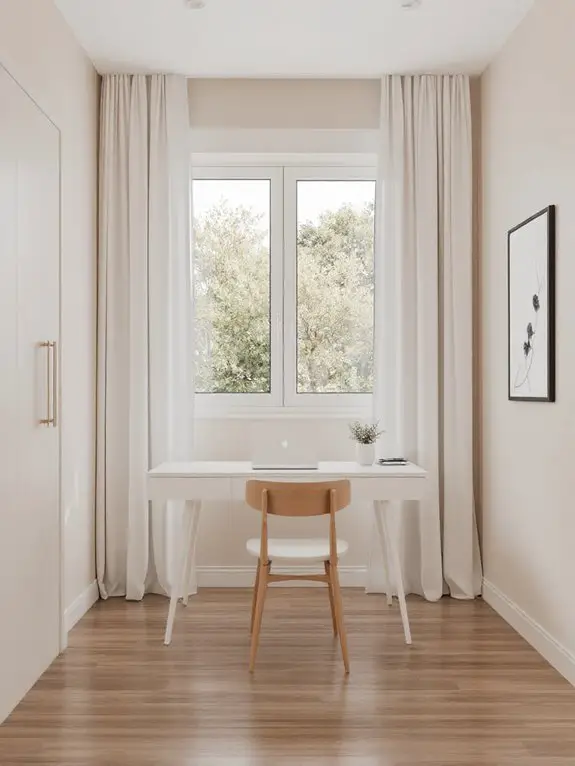
To achieve a clean, minimalist look in my home office, I’ve found that hanging curtains is an effective way to enhance the space without adding clutter. I opt for neutral-colored, floor-length curtains in materials like linen or cotton, as they create a cohesive and serene ambiance.
Mounting the curtain rod close to the ceiling and extending it slightly beyond the window frame makes the room feel taller and more open. I also make certain the curtains blend seamlessly with the wall color to maintain simplicity.
This approach softens the space while keeping it orderly and visually uncluttered.
Implement a Paperless Filing System
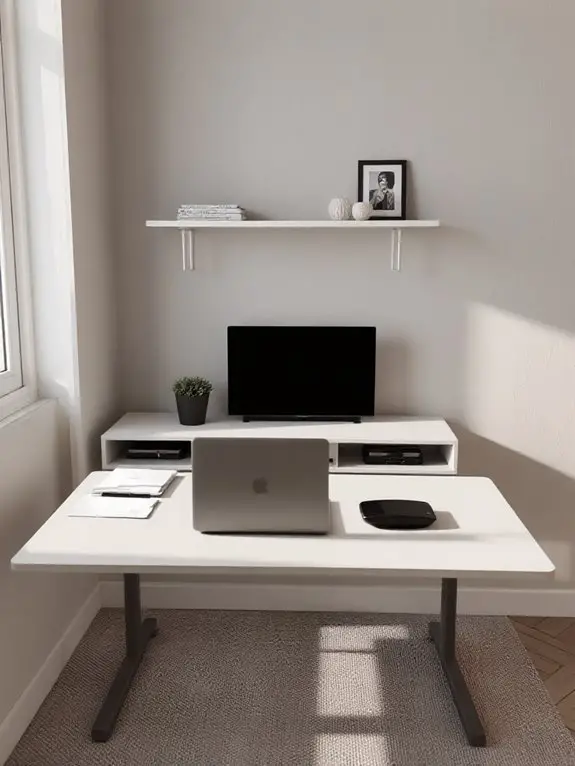
Since reducing physical clutter is essential for a minimalist home office, I’ve shifted to a paperless filing system to streamline organization and maximize efficiency. By scanning documents and saving them to cloud storage, I’ve eliminated the need for bulky filing cabinets.
I use apps like Google Drive or Dropbox to categorize and label files for easy access. It’s been a game-changer—no more misplaced papers or time wasted searching. Plus, it’s eco-friendly!
I’ve also started digitally signing documents and opting for electronic invoices whenever possible. A paperless system keeps my workspace clean and lets me focus on what truly matters.
Use Uniform Storage Containers
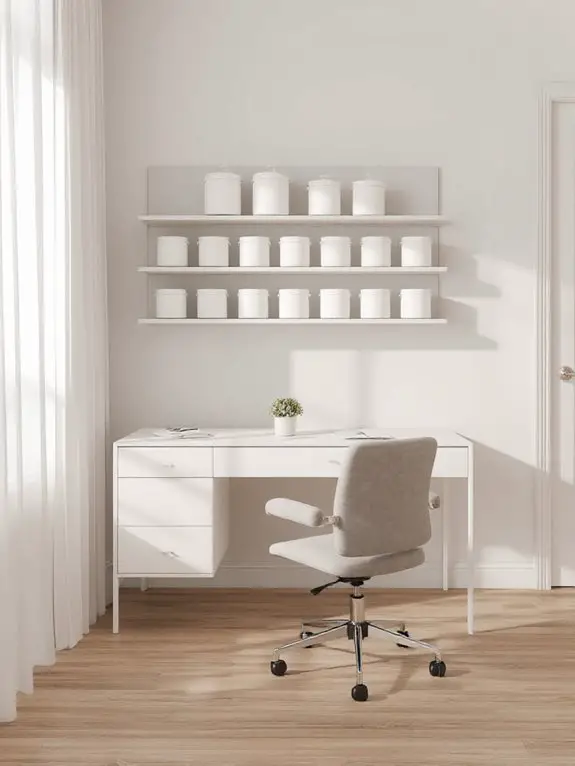
Choosing uniform storage containers has transformed the organization in my minimalist home office. By using containers of the same size, shape, and color, I’ve created a cohesive look that reduces visual clutter.
Stackable bins and modular drawers maximize vertical space, keeping everything accessible yet out of sight. Labels guarantee I can quickly find what I need without rummaging.
Clear bins work well for items I use frequently, while opaque ones hide less-used supplies. This consistency not only simplifies storage but also reinforces the minimalist aesthetic, making my workspace feel calm and intentional.
It’s a small change with a big impact.
Maintain a Clear and Open Floor Space
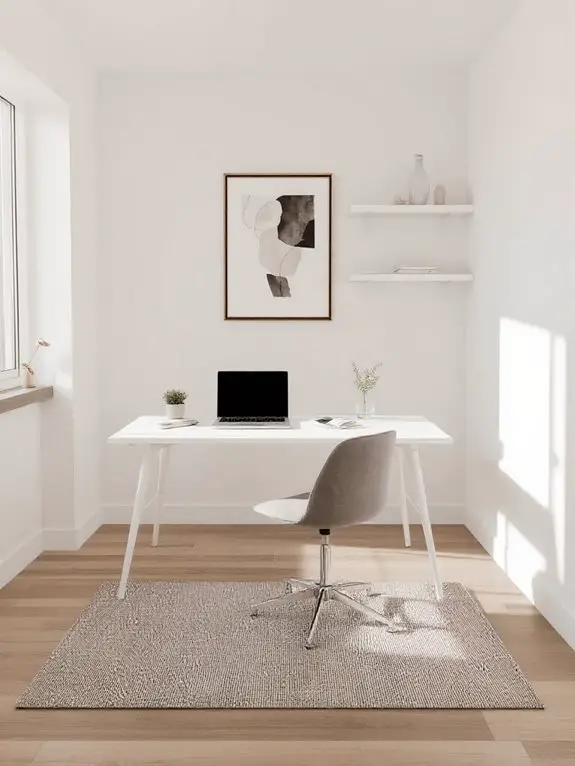
Maintaining a clear and open floor space in my minimalist home office has been essential for creating a sense of calm and focus. I’ve found that removing unnecessary furniture and keeping only what I use daily reduces distractions. I make sure cords are neatly tucked away and choose sleek, multifunctional pieces that don’t clutter the area.
Regularly decluttering prevents items from piling up, and I always return things to their designated spots. This approach not only makes the room feel more spacious but also boosts productivity.
A clear floor space allows me to move freely and think clearly, making my workspace a haven for creativity.
Frequently Asked Questions
How to Choose Eco-Friendly Office Materials?
I look for office materials made from recycled or sustainable sources, like bamboo or FSC-certified wood. I avoid plastics and opt for refillable pens, recycled paper, and non-toxic adhesives to reduce my environmental impact while working.
What Are Budget-Friendly Minimalist Office Ideas?
Did you know 70% of clutter impacts productivity? I’d focus on essentials—a simple desk, a comfy chair, and natural light. I’d repurpose what I own, like using a bookshelf for storage, and stick to neutral colors.
How to Maximize Small Office Space Effectively?
I’ve learned to maximize my small office space by using vertical storage, like shelves and wall organizers, and multi-functional furniture, such as a desk with drawers. I’ll keep it clutter-free and only have what I truly need.
Which Ergonomic Furniture Fits Minimalist Aesthetics?
I’d focus on ergonomic furniture that’s both functional and sleek. I’d choose a minimalist chair with clean lines, a height-adjustable desk in neutral tones, and maybe a compact storage unit that doesn’t clutter the vibe.
How to Maintain Focus in a Minimalist Office?
I keep distractions at bay by decluttering my workspace and sticking to essentials. I set clear goals, use a timer for focused work intervals, and limit tech use for unrelated tasks to stay on track.

